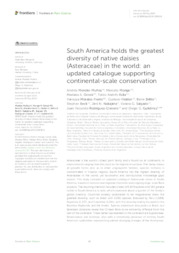South America holds the greatest diversity of native daisies (Asteraceae) in the world: an updated catalogue supporting continental-scale conservation.
South America holds the greatest diversity of native daisies (Asteraceae) in the world: an updated catalogue supporting continental-scale conservation.
Author(s): MOREIRA-MUÑOZ, A.; MONGE, M.; GROSSI, M. A.; CASTILLO, F. A. A.; MORALES-FIERRO, V.; HEIDEN, G.; BRITTO, B.; BECK, S.; NAKAJIMA, J. N.; SALGADO, V. G.; RODRÍGUEZ-CRAVERO, J. F.; GUTIÉRREZ, D, G.
Summary: Abstract: Asteraceae is the world’s richest plant family and is found on all continents, in environments ranging from the coast to the highest mountains. The family shows all growth forms and, as in other angiosperm families, species richness is concentrated in tropical regions. South America has the highest diversity of Asteraceae in the world, yet taxonomic and distributional knowledge gaps remain. This study compiles an updated catalog of Asteraceae native to South America, based on national and regional checklists and ongoing large-scale flora projects. The resulting checklist includes a total of 6,940 species and 564 genera native to South America to date, which represent about a quarter of the family’s global diversity. Countries already considered to be megadiverse show the greatest diversity, such as Brazil with 2,095 species, followed by Peru (1,588), Argentina (1,377), and Colombia (1,244), with this diversity mainly focused on the Brazilian Highlands and the Andes. Species endemism also peaks in Brazil, but Sørensen distances reveal the Chilean flora to be eminently different from the rest of the continent. Tribes better represented in the continent are Eupatorieae, Senecioneae and Astereae, also with a remarkably presence of entirely South American subfamilies representing earliest diverging lineages of the Asteraceae, such as Barnadesioideae, Wunderlichioideae, Famatinanthoideae, and Stifftioideae. It is estimated that the discovery and description curves have not yet stabilized, and the number of species is likely to increase by 5 to 10% in the coming years, posing major challenges to continental-scale conservation.
Publication year: 2024
Types of publication: Journal article
Keywords: Andes region, Asteraceae, Biodiversidade, Brazilian Plateau, Compositae (Asteraceae), Conservation plants, Conservação em larga escala, IUCN, Large-scale conservation, Margarida, Megadiverse countries, Planalto Brasileiro, Species diversity, União Internacional para Conservação da Natureza
Observation
Some of Embrapa's publications are published as ePub files. To read them, use or download one of the following free software options to your computer or mobile device. Android: Google Play Books; IOS: iBooks; Windows and Linux: Calibre.
Access other publications
Access the Agricultural Research Database (BDPA) to consult Embrapa's full library collection and records.
Visit Embrapa Bookstore to purchase books and other publications sold by Embrapa.

